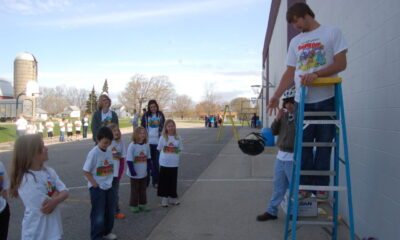Outdoors
Golden rules of ATV and UTV safety to know before hitting the trails or heading out for chores

Whether used as an essential piece of farm equipment or for recreation on trails, ATVs and UTVs require serious attention to safety.
“We tend to lose our safety focus when we’re utilizing them, or we don’t use them correctly,” Jana Davidson, education content specialist for the Progressive Agriculture Foundation said.
Understanding appropriate age and size is important, according to Davidson. One common misconception she pointed out is that the long seat of an ATV can be used to carry multiple passengers. ATVs are designed for one rider. The long seat is designed to help the driver shift body weight while moving up and down hills.
“You can’t do that when you have an extra rider because it really changes the center of gravity,” Davidson said. “It is also hard to do if you are not on the appropriate size equipment.”
Even adding extra weight from farm use or hunting such as hay bales or a deer carcass can cause challenges that drivers need to be aware of to avoid an accident.
“Maybe you’ve done the same trail several times a day, a hundred times a year, but when you add something different, it is going to completely change how that vehicle behaves and maneuvers,” Davidson said.
According to the 2020 Fact Sheet from the National Children’s Center for Rural and Agricultural Health and Safety (NCCRAHS) based out of Marshfield, Wis., transportation incidents (including tractors, ATVs, and UTVs) are among the most fatal for youth in agriculture.
“We are constantly getting alerts about children that were injured or sometimes killed because of an ATV or UTV incident,” Davidson said. “It is just heartbreaking because behind it all, you know these could have been prevented if only they had a helmet or didn’t have an extra rider.”
The ATV Safety Institute has a list of eight golden rules to follow when riding an ATV or UTV.
- Always wear a Department of Transportation (DOT) compliant helmet, goggles, long sleeves, long pants, over-the-ankle boots, and gloves. Selection of Personal Protective Equipment (PPE) plays a crucial role in your safety from your head to your toes. The safer you will be when you select the appropriate PPE!
- Never ride on paved roads except to cross when done safely and permitted by law, as another vehicle could hit you. ATVs are designed to be operated off-highway.
- Never ride under the influence of alcohol or drugs. Also, never allow others who appear to be under the influence to operate an ATV or UTV.
- Never carry a passenger on a single-rider ATV, and no more than one passenger on an ATV specifically designed for two people. Most ATVs are designed for one rider at a time, so you can be rider active and move with the vehicle. When going down an incline (shift to the back), when going up an incline (shift to the front) or when turning (shift left or right).
- Ride an ATV that is right for your age and also size appropriate. Although all youth vehicles are designed for children to travel at slower speeds, every child differs in his or her physical and developmental abilities, which needs to be considered when handling an ATV.
- Supervise riders younger than 16. Always remind younger riders that ATVs are not toys.
- Ride only on designated trails and at a safe speed.
- Become safety savvy by taking a hands-on ATV RiderCourse and the free online E-Course. Visit ATVsafety.org or call 800-887-2887 to learn more.
In 2019, ATV safety reached more than 46,000 youth participants and was one of the top lessons taught at Progressive Agriculture Safety Days. Unfortunately, COVID-19 canceled most plans for hands-on learning in 2020, but the Progressive Agriculture Foundation is accepting applications to host safety days in 2021. Those applications are due July 15.
“We’re really excited and hoping the comeback,” Davidson said. “If can save one life or prevent an injury, it is all worth it.”
The Progressive Agriculture Foundation provides all resources, and training for coordinators can be completed online. The curriculum has more than 30 topics of hands-on activities, demonstrations, and lesson plans available. Youth who participate receive t-shirts, take-home bags, and insurance coverage.
Until in-person lessons continue, Progressive Agriculture safety day is offering tips and information on social media and through virtual lessons.







